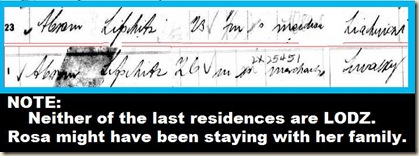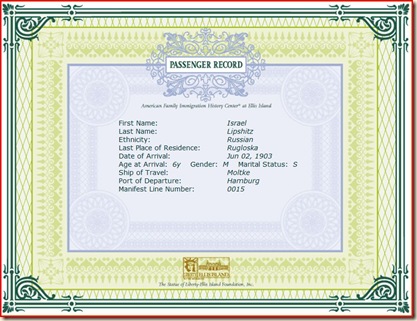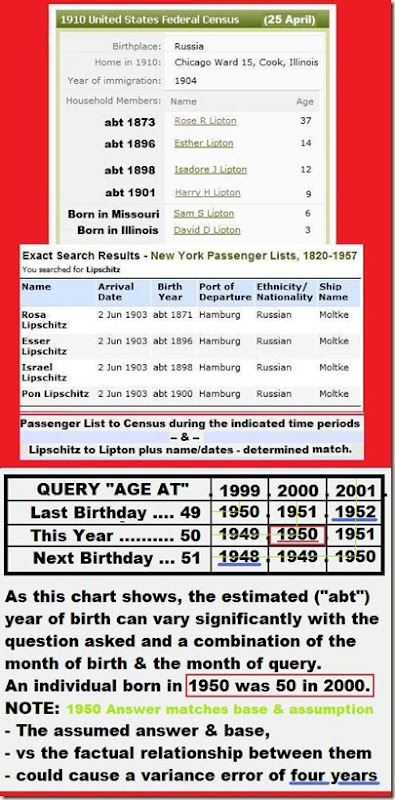I tried to find SOLID biographical data on Lawrence Lipton -- couldn't, so researched on Ancestry.com and came up with this:
"Lawrence Lipton (October 10, 1898 - July 9, 1975) was an American journalist, writer, and beat poet, as well as the father of James Lipton."
Lawrence Lipton was born in Lodz, Poland (Russian region) October 10, 1898 -- son of Rose and Abraham. Exactly what the family name was prior to arrival in America is uncertain, but, once here, they assumed the LIPTON surname. Prior to assuming the given name of Lawrence, this artist, journalist, writer, and beat poet was Isadore J Lipton, son of Rose and Abraham; brother to Esther (b.1895 in Poland), Harry (b.10 Jun 1900[or 1899] in Poland), Sam (b.1904 in Missouri) and David (b.1907 in Illinois).
The family appears to have journied to the United States late in 1903, or early 1904; upon arrival, continued on to Chicago, Illinos where Abraham died sometime priod to the April 1910 Census; Rose appears to have remained there for the rest of her life. At that time, they lived at 1142 North Wood Street -- a residence which, on Google Maps, is shown to be For Sale. In that census, their language is shown as Yiddish and their year of immigration, 1904. The same census shows two girls who might be Isadore's first wife, Dorothy Omansky. One is an orphan, Dora Omansky (b.1899 in Russia), who arrived in America in 1907 and is recorded among the 143 'inmates' at the Jewish Orthodox 'Marks Nathan Jewish Orphan Home' (1243, 1249 N. Wood St.); the other, Dorah (b.1904), daughter of Max Omansky, is living a half mile away -- at 712 (North) Paulina Street. The 1930 census reveals that Max's daughter married Solly Goldstien -- and, therefore, cannot be the Dorothy who married Isadore in the early 1920's. This leaves Dora Omansky as the likely first wife to Isadore.
1910 Census has Orphanage on Blucher Street, whose name and numbers were changed after WW2: The Blucher St. address is now the corner of W Potomac Ave. & N. Wood St.; thus placeing it only a tenth of a mile from Isadroe's 1910 residence. Available information indicates that Dorothy and Lawrence were childhood friends -- this is consitent with a one year age difference that would have placed both in the same grade, while their proximity would have them running in the same childhood clique.
Moving on to the 1920 Census, we find the 22 year old Isadore living, with his mother and three younger brothers, at 2145 division Street. The census tells us that Isadore is single and working as Studio Artist -- it is in this period that he won an award for his illustration of Haggadah, a Passover prayer book. During the 1920s, Lipton turned his hand to journalism and became a regular contributor to the Sunday feature section of the New York Jewish newspaper, Forverts; became publicity director of a large movie theater; wrote for Atlantic Monthly, The Quarterly Review of Literature, and the Chicago Review -- in the process becomming associated with Chicago writers Edgar Lee Masters, Sherwood Anderson, Carl Sandburg, Harriet Monroe, and Ben Hecht -- who lived only a mile away from Isadore and Dora. We can presume that 'Dorothy Omansky', who is roughly the same age as Isadore & Hecht, is traveling in the same circles -- in the 1920 census, Hecht is shown as being 23 years old, as opposed to the 26 years his biographical age would infer (a similar age variance shows for Sherwood Anderson).
Some time in the early 1920's, Isadore (Lawrence) married Dora (Dorothy), who is generally described as his "childhood sweetheart"; a shot time later Dorothy died. Around 1926, Lawrence Lipton married the 32 year old 'Betty Weinberg' (b.1894) -- their union produced a son, Louis James Lipton (b. Detroit, Mich, 19 Sept 1926), By the 1930 census, Betty and 'Lous' (James) Lipton were living with Betty's parents in Detroit and Lawrence was out of the picture. The census record also shows Betty's sister -- who, like Betty, was a teacher -- and her brother, a writer working in advertising. James Lipton grew to be a writer, poet, composer and dean emeritus of the Actors Studio Drama School of my alma mater, Pace University.
Of himself, Lawrence has written that he was "compelled to work for a living from then on; forced to fight a running battle against time for my education (time stolen from sleep, from play, from work--and consequently from food very often), and lacking the kind of life continuity and integrated personality that gives a man a firm sense of purpose and direction."
After seperating from Betty, Lawrence married Georgiana Ann Randolph Craig (1908–1957), with whom he coauthored twenty-two books of mystery fiction during the late 1930s and early 1940s under the pseudonym of Craig Rice. After this marriage ended in divorce.
In 1948, Lawrence then married his forth wife, Nettie Esther Brooks. He died in Los Angeles, California on 9 July 1975 -- his widow also passed away in Los Angeles, at the age of 74, on 10 Dec 1986.
Lawrence Lipton went on to write:
_The Laugh is Bitter (1942)
_In Secret Battle (1944),
_ Rainbow at Midnight (1955) - poetry,
_The Holy Barbarians._ New York: Messner, 1959.
_The Erotic Revolution._ Los Angeles: Sherbourne Press, 1965.
Nettie Lipton: From the Dictionary of Literary Biography, Volume 16: The Beats: Literary Bohemians in Postwar America. Edited by Ann Charters, University of Connecticut. Gale Research, 1983. pp. 352-356.
The Holy Barbarians, the book that linked Lipton to the Beat writers, was published in 1959, when he was sixty-one years old. The cast of characters in the book included such "name" personalities as the writers Allen Ginsberg, Kenneth Rexroth, Kenneth Patchen, Stuart Z. Perkoff, Gregory Corso, Lawrence Ferlinghetti, and Dylan Thomas. When Lipton wrote The Holy Barbarians he had settled in Venice, California, where a bohemian community flourished beside the Pacific Ocean, near the beach outside Los Angeles. Lipton's home became an informal center for the arts, with Lipton functioning as both teacher and catalyst. In the years immediately after the mid-1950s poetry renaissance in the San Francisco Bay Area, poets, writers, and artists often went down the coast to visit Lipton. For Lipton, poetry readings were at the heart of the Beat experience in Venice, helping to explain "the alienation of the hipsters from the squares." He stated that "when the barbarians appear on the frontier of a civilization it is a sign of a crisis in that civilization. If the barbarians come, not with weapons of war but with songs and ikons of peace, it is a sign that the crisis is one of a spiritual nature."
In Venice, Lipton had been associated with the movement to restore poetry as a vocal art long before the Beats became famous. "The printed poem is to the poem what the score is to a piece of music," he wrote in his essays "Poetry and the Vocal Tradition" and "Youth Will Serve Itself" in the Nation in April and November 1956.
Lipton began experimenting with poetry and jazz in 1956. Working first with Shelly Manne, then briefly with Jimmie Giuffre and Buddy Collette, he perfected his concepts of the integration of poetry with jazz music. In September 1957, Benny Carter and Jack Hampton, after hearing Lipton in a discussion about poetry and jazz with Kenneth Rexroth on a Los Angeles-San Francisco hookup on CBS radio, called on him to produce and direct a series of poetry-and-jazz concerts. The result was the First West Coast Poetry and Jazz Festival, dedicated to Dylan Thomas and playing to capacity audiences during its two-week run in early December. For these concerts Lipton drew upon the musical talents of Shorty Rogers, Bill Holman, Barney Kessel, Paul Horn and the poetry of Kenneth Rexroth, Stuart Z. Perkoff and several other young Venice poets. His own poems were included as well. In 1958 Lipton produced Jazz Canto, released by World Pacific Records.
After The Holy Barbarians, Lipton turned to the sexual revolution. He believed it to be a determined move on the part of millions of people to restructure the very process of orgasm itself. In The Erotic Revolution (1965), he recommended: "Repeal all the laws regulating pre-marital sex; Make legal marriage optional; Repeal all laws making homosexuality illegal; Repeal all the so-called 'unnatural laws' regarding the sexual act; Make contraceptives legal everywhere and free to low income groups; Make all abortions legal and free to those unable to pay."
Published in dozens of literary magazines and journals, his poetry and prose gathered together certain central themes that related to the social responsibility of the artist to participate in the formation of a society that was more than a collective. As a visionary, Lipton wanted the new society to be rational, functional, and responsible to the deepest needs of the human soul.
During the last years of his life, Lipton wrote a long-running column of political commentary in the Los Angeles Free Press called "Radio Free America".






